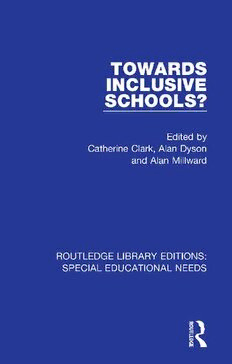Table Of ContentROUTLEDGE LIBRARY EDITIONS:
SPECIAL EDUCATIONAL NEEDS
Volume 6
TOWARDS INCLUSIVE
SCHOOLS?
TOWARDS INCLUSIVE
SCHOOLS?
Edited by
CATHERINE CLARK, ALAN DYSON
AND ALAN MILLWARD
Firstpublishedin1995byDavidFultonPublishersLtd
Thiseditionfirstpublishedin2019
byRoutledge
2ParkSquare,MiltonPark,Abingdon,OxonOX144RN
andbyRoutledge
711ThirdAvenue,NewYork,NY10017
RoutledgeisanimprintoftheTaylor&FrancisGroup,aninforma
business
©1995DavidFulton(Publishers)Limited
Allrightsreserved.Nopartofthisbookmaybereprintedor
reproducedorutilisedinanyformorbyanyelectronic,mechanical,
orothermeans,nowknownorhereafterinvented,including
photocopyingandrecording,orinanyinformationstorageor
retrievalsystem,withoutpermissioninwritingfromthepublishers.
Trademarknotice:Productorcorporatenamesmaybetrademarksor
registeredtrademarks,andareusedonlyforidentificationand
explanationwithoutintenttoinfringe.
BritishLibraryCataloguinginPublicationData
AcataloguerecordforthisbookisavailablefromtheBritishLibrary
ISBN:978-1-138-58532-4(Set)
ISBN:978-0-429-46809-4(Set)(ebk)
ISBN:978-1-138-60319-6(Volume6)(hbk)
ISBN:978-0-429-46908-4(Volume6)(ebk)
Publisher’sNote
Thepublisherhasgonetogreatlengthstoensurethequalityofthis
reprintbutpointsoutthatsomeimperfectionsintheoriginalcopies
maybeapparent.
Disclaimer
Thepublisherhasmadeeveryefforttotracecopyrightholdersand
wouldwelcomecorrespondencefromthosetheyhavebeenunableto
trace.
Additional publisher’s Note
These are re-issues of books published some years ago which are
inevitably a reflection of the time in which they were published. The
language used is indicative of that time and as such no offence is
intended by the re-issuing of the books.
Preface to the 2018 Re-issue
The early 1990s, when this book was published, were important years
in the history of special education. For some time, various countries
had been developing ways of educating children identified as having
disabilities and/or special educational needs alongside their peers
in regular schools. For the most part, these developments had been
fragmented. Different countries used different terminology, targeted
different groups of children, worked within different legal and ad-
ministrative frameworks, and had different ideas about how schools
should operate and what kind of education they should deliver.
In 1994, however, UNESCO issued the Salamanca Statement (UNE-
SCO 1994). This declared ‘inclusion’ to be the right of all children and
called on all countries to develop inclusive schools. For the first time it
seemed that countries might be able to develop their provision within
a common framework of ideas, language and practices. Certainly in
the decades since then ‘inclusive education’ has had all the appearance
of an international movement, uniting very different systems in a joint
endeavour to ensure that all their children have access to the same
educational rights and entitlements.
This book marked an early attempt to explore in this context how
educators working in different systems might learn from each other’s
thinking and practice. It did this by inviting a range of international
experts to write about developments in their own countries and the
findings of their own research. Based on this, the editors set out a
framework which outlines the different approaches to inclusion that
have emerged internationally and suggests ways in which researchers
and practitioners can speak to each other from within those different
approaches.
The rapid development of inclusive education initiatives across the
world in the past two decades would undoubtedly mean that some
aspects of this book would change if it were being written today. If
nothing else, there would be more emphasis on the experiences of
low- and middle-income countries. However, the substantive issues
addressed by individual chapters remain important – how is inclusive
education to be resourced, how are teachers to be developed for in-
clusion, what kinds of school practices are most inclusive? Readers
will find here some intriguing suggestions as to how questions might
be answered – suggestions that they can adapt to their own particular
contexts.
However, the book offers more than a few practical suggestions.
The authors also tackle fundamental questions – about what we re-
ally mean by ‘inclusive education’, about what kinds of knowledge,
research and thinking support inclusion and, above all, about how
educationalists working in very different contexts might share what
they know? Despite all the developments of recent decades, these ques-
tions remain as vital today as they were when this book was written.
This book, therefore, offers an important resource for readers every-
where who are engaged in working for more equitable, more inclusive
education.
Alan Dyson
January 2018
Reference
UNESCO (1994) The Salamanca Statement and Framework for Action on Spe-
cial Needs Education. Adopted by the World Conference on Special Needs
Education: Access and Quality (Salamanca, Spain, June 7-10, 1994). Min-
istry of Education and Science, Madrid (Spain); United Nations Educa-
tional, Scientific, and Cultural Organization, Paris (France).
TOWARDS INCLUSIVE
SCHOOLS?
Edited by
Catherine Clark, Alan Dyson
and Alan Millward
David Fulton Publishers
London

